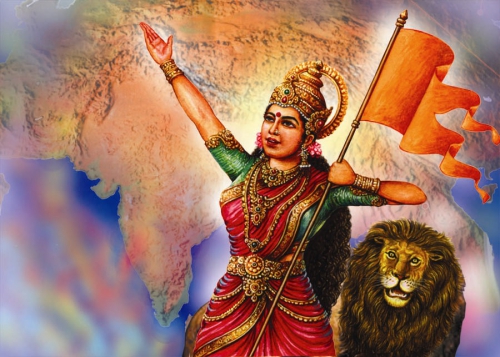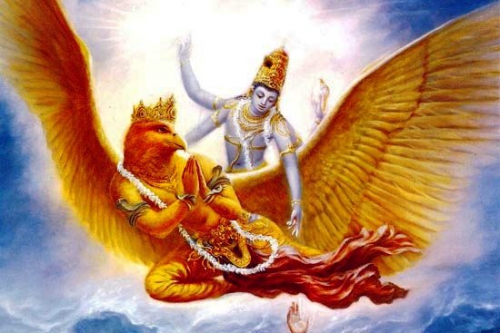The following article is from chapter 3 of the groundbreaking new work “The Dharma Manifesto“, by Sri Dharma Pravartaka Acharya.
By Sri Dharma Pravartaka Acharya
The Abrahamic worldview is today represented by five closely aligned ideological tendencies: 1) Judaism, 2) Pauline Christianity, 3) Islam, 4) Marxism, and to a less significant extent 5) the Baha’i movement. Of these Abrahamic tendencies, Marxism is the only self-stated atheistic one, the others being religious in nature. The greatest real-world challenge and exact philosophical juxtaposition to the entire Dharmic worldview has historically been, and continues to this day to be, the Abrahamic mentality and worldview.
While some very important theological and ritual distinctions can be seen between them all, nonetheless the specifically religious-oriented aspects of Abrahamism – Judaism, Christianity and Islam – share a common worldview, psychological make-up, and guiding ethos. Judaism, Christianity and Islam are historically referred to as the “Abrahamic” religions because all three religions trace their origins to the prophet Abraham, and can thus be seen to be quite similar in many aspects of their respective outlooks. The following are only a few of the similarities that they all share.
1. All three religions have a shared acceptance of the teachings of the Old Testament prophets (Christianity, in addition to the accepting the Old Testament prophets, also accepts Jesus. Islam, in addition to the Old Testament prophets and Jesus, also accepts Muhammad).
2. Anthropomorphic monotheism. The supreme god of Abrahamism is seen in very human terms, including in his exhibition of such very human emotions as anger, jealousy, prejudice and vengeance.
3. A profound sense of religious exclusivity, creating two strictly delineated camps of “believers” in opposition to everyone else.
4. The belief that there is only the sole true faith, and that any other form of religious expression external to the “one true faith” is necessarily wrong.
5. The acceptance of terrorism, violence, mob action, looting and aggressive missionary tactics to spread their religion.
6. A common sense of being at a war to the death with the Dharmic (“Pagan”) world that preceded Abrahamic ascendency.
7. The centrality of unidirectional prayer to commune with their god, with systematic meditation practice playing either little or no part in the practice of their respective religions.
8. A belief in the existence of angels, the devil, demonic spirits, etc.
9. All three teach the bodily resurrection, the Final Judgment, the creation of the soul at the time of conception or birth (as opposed to the soul’s pre-existence, which all Dharmic spiritual traditions teach), the binding effects of sin, etc.
10. The importance of a specific holy day of the week set aside for prayer and rest: For Jews – Saturday. For most Christians – Sunday. For Muslims – Friday.
These are only a few of the elements of the Abrahamic worldview, of which mainstream Christianity is an integral part.
Up until 2000 years ago, the Dharmic worldview was by far the predominant worldview for most of humanity – from Ireland in the West to the Philippines in the East. Though there were thousands of diverse individual cultures, languages, foods, customs and traditions among the ancient Indo-European peoples, most of these ethnically varied cultures were united in their deep respect for, and attempted adherence to, the Natural Way (Dharma).
This ancient uniformity in adherence to Dharma was the case for tens of thousands of years until the radically anti-human and anti-nature Abrahamic ideology suddenly burst upon the world scene 4000 years ago with an evangelical fury, religiously-inspired violence, and zealous civilization-destroying vengeance the likes of which the civilized world had never seen previously. Never before had the multiple ancient and noble pre-Christian cultures of the world ever experienced such massive destruction, death, persecution, forced conversion, and cultural annihilation performed in the name of an artificially expansive religion as it witnessed at the hands of the new Abrahamic ideology that had arrived, seemingly out of nowhere, onto the world stage. It was in the wake of this never before experienced juggernaut of Biblically inspired destruction that the light of Dharma began to swiftly wane, and that Reality as it was known up till then was turned literally on its head.
Religiously inspired imperialism began with the more localized expansion of the Israelites in the Levant region two thousand years before the birth of Christianity.[1] However, it was soon after the appropriation of the original teachings and spiritual movement of Jesus, and the massive expanse of this later, corrupt form of post-Constantine Christianity, that the expansion of the Abrahamic ideology began to take on truly global proportions. As the French thinker Alain de Benoist explains this catastrophe in the context of European history,
“. . . the conversion of Europe to Christianity and the more or less complete integration of the European mind into the Christian mentality, was one of the most catastrophic events in world history – a catastrophe in the proper sense of the word…”[2]
With the ascent of the Abrahamic onslaught came the counter-proportional descent of the Indo-European world’s traditional Dharmic civilizations.

Christianity, in retrospect, was but one of several artificially constructed, new movements that all fall under the general term “Abrahamic”, named after the infamous founder of fanatical religious exclusivity, Abraham (1812 BC – 1637 BC). These four anti-nature ideologies are 1) Judaism, 2) Christianity, 3) Islam, and 4) Marxism. Whether we speak of Judeo-Christian “holy wars” and Inquisitions, or the bloody and unending Islamic jihads against “infidels”, or the genocide of over 100 million people in the name of Marxist revolution, all four of these Abrahamic movements have been responsible for more destruction, loss of life, and social mayhem than all other ideas, religions, and ideologies in world history combined.
The Abrahamic onslaught has been an unparalleled juggernaut of death. More, while all four ideologies have remained seemingly divided by dogmatic, sectarian concerns, all Abrahamic movements have been fanatically united in both their common origin, and in their shared aim of annihilating their perceived enemy of Dharma from the earth, and seeking sole domination of world power for themselves alone. While Judaism, Christianity and Islam have been at war with each other for millennia, they are all united in their insistence that Dharma is their principal hated enemy. The essential driving principle of Abrahamism is to bring about the immediate death of Dharma.
Dharma and Abrahamism are exact opposites in every way. Dharma and Abrahamism stand for two radically opposed visions for humanity’s future. Dharma stands for nature, peace, diversity, and reason. Abrahamism stands for artificiality, war, uniformity, and fanaticism. They are the only two real ideological poles of any true significance in the last two-thousand years. There has been an ongoing Two-Thousand Year War between these two opposing worldviews that has shaped the course of much of human history since this conflict’s start. Every philosophical construct, religious denomination, political ideology and general worldview of the past two millennia falls squarely into one camp or the other. Every human being living today falls squarely into one camp or the other. Dharma and Abrahamism are the only two meaningful ideological choices for humanity today. And for all too much of the duration of this Two-Thousand Year War, Dharma has been on the losing end as Abrahamism has continuously succeeded in its unrivalled ascendancy.
The destructive ascendancy of Abrahamism is, however, about to come to an end. We are now about to witness a period of Dharmodaya – of Dharma ascending – in this very generation. As is explained in thorough detail in the two books “The Dharma Manifesto” and “Sanatana Dharma: The Eternal Natural Way”, we are about to experience the rebirth of Dharmic and Vedic civilization throughout the totality of our world.
The Dharma world-view represents a positive moral and philosophical alternative to the many ills and cultural distortions of Abrahamic modernity. Vedic culture is human culture, because Vedic culture is the model of spiritual civilization. Our world is not without meaning. Our future is not without hope. Though the darkness of the Kali Yuga (our current “Age of Conflict”) and a civilizational crisis has now descended upon us, the Sun of Dharma will soon be seen again. No cloud can obscure our vision of the Sun forever. We will live to see Dharma triumphant again, and to see a Golden Age of compassion, true culture, and the Natural Way be firmly established.
[1] One of the prime example of such Abrahamist expansion was the conquest of Canaan (circa 1400-1350 BC), described in the Book of Joshua and the first chapter of Judges.
[2] Alain de Benoist, On Being a Pagan, ed. Greg Johnson, trans. Jon Graham (Atlanta: Ultra, 2004), p. 5.
_______________________
This article is from chapter 3 of the groundbreaking new political work “The Dharma Manifesto“, by Sri Dharma Pravartaka Acharya.
The Dharma Manifesto serves as the first ever systematic revolutionary blueprint for the nascent global Vedic movement that will, in the very near future, arise to change the course of world history for the betterment of all living beings. The Dharma Manifesto signals the beginning of a wholly new era in humanity’s eternal yearning for meaningful freedom and happiness.
About the Author
Sri Dharma Pravartaka Acharya has been acknowledged by many Hindu leaders throughout the world to be one of the most revolutionary and visionary Vedic spiritual masters on the Earth today.
With a forty year history of intensely practicing the spiritual disciplines of Yoga, and with a Ph.D. in Religious Studies, Sri Acharyaji is one of the most eminently qualified authorities on Vedic philosophy, culture and spirituality. He is the Director of the Center for the Study of Dharma and Civilization.
His most historically groundbreaking politico-philosophical work, “The Dharma Manifesto“, is now offered to the world at a time when its people are most desperately crying out for fundamental change.





 del.icio.us
del.icio.us
 Digg
Digg